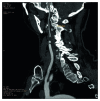Surgical Treatment of Proximal Segmental Occlusion of the Internal Carotid Artery
- PMID: 30719497
- PMCID: PMC6334308
- DOI: 10.1155/2019/2976091
Surgical Treatment of Proximal Segmental Occlusion of the Internal Carotid Artery
Abstract
Purpose: To present the feasibility, safety, and efficacy of carotid endarterectomy in patients with type II internal carotid artery occlusions, including the long-term outcomes.
Methods: From March 2008 to August 2015, 74 consecutive patients (48 men with a mean age of 65.1 ± 8.06 years) underwent carotid endarterectomy because of internal carotid artery (ICA) segmental occlusions. These were verified with preoperative carotid duplex scans (CDS) and CT angiography (CTA). Also, brain CT scanning was performed in all these patients. The indication for treatment was made jointly by a vascular surgeon, neurologist, and an interventional radiologist in a multidisciplinary team (MDT) context. After successful treatment, all the patients were followed-up at 1, 3, 6, and 12 months, then every 6 months thereafter.
Results: The most common symptom at presentation was transient ischaemic attack (TIA) in 49 patients (66.2%), followed by stroke in the past six months in the 17 remaining patients (23%). Revascularisation of the ICA with endarterectomy techniques was performed successfully in all the patients with an average clamp time of 11.9 min. All the procedures were performed under general anaesthesia in combination with a superficial cervical block. The early complication rate was 8.1% and included two cardiac events (2.7%) (one rhythm disorder and one acute coronary syndrome), three TIAs (4.1%), and one intracerebral hemorrhage (1.3%). Only one patient with the intracerebral hemorrhage died 5 days after surgery giving a postoperative mortality of 1.3% for this series. During the follow-up period (mean 50.4 ± 31.3 months), the primary patency rates at 1, 3, 5, and 7 years were 98.4%, 94.9%, 92.9%, and 82.9%, respectively. Likewise, the survival rates were 98.7%, 96.8%, 89%, and 77.6%, respectively. Ultrasound Doppler controls during follow-up detected 8 ICA restenoses; however, only 3 of these patients required further endovascular treatment.
Conclusions: Carotid endarterectomy of internal carotid artery (ICA) segmental occlusion is a safe and effective procedure associated with acceptable risk and good long-term results. Therefore, the current guidelines which do not recommend carotid endarterectomy in this patient group should be reassessed, with the requirement for ongoing large-scale randomized controlled trials to compare CEA with best medical therapy in this patient cohort.
Figures






References
-
- Gomensoro J. B. Joint study of extracranial arterial occlusion. 8. Clinical-radiographic correlation of carotid bifurcation lesions in 177 patients with transient cerebral ischemic attacks. JAMA: The Journal of the American Medical Association. 1973;224(7):985–991. doi: 10.1001/jama.224.7.985. - DOI - PubMed
LinkOut - more resources
Full Text Sources
Miscellaneous

